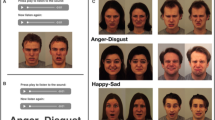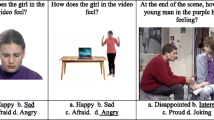Abstract
The current study investigated whether those with higher levels of autism-like traits process emotional information from speech differently to those with lower levels of autism-like traits. Neurotypical adults completed the autism-spectrum quotient and an emotional priming task. Vocal primes with varied emotional prosody, semantics, or a combination, preceded emotional target faces. Prime-target pairs were congruent or incongruent in their emotional content. Overall, congruency effects were found for combined prosody-semantic primes, however no congruency effects were found for semantic or prosodic primes alone. Further, those with higher levels of autism-like traits were not influenced by the prime stimuli. These results suggest that failure to integrate emotional information across modalities may be characteristic of the broader autism phenotype.

Permission to publish these stimuli was obtained from the stimuli developer Marc D. Pell


Similar content being viewed by others
References
Austin, E. J. (2005). Personality correlates of the broader autism phenotype as assessed by the Autism Spectrum Quotient (AQ). Personality and Individual Differences, 38, 451–460. https://doi.org/10.1016/j.paid.2004.04.022.
Baron-Cohen, S., Wheelwright, S., Skinner, R., Martin, J., & Clubley, E. (2001). The Autism-Spectrum Quotient (AQ): Evidence from Asperger syndrome/high-functioning autism, males and females, scientists and mathematicians. Journal of Autism and Developmental Disorders, 31(1), 5–17. https://doi.org/10.1023/A:1005653411471.
Begeer, S., Koot, H. M., Rieffe, C., Terwogt, M. M., & Stegge, H. (2008). Emotional competence in children with autism: Diagnostic criteria and empirical evidence. Developmental Review, 28, 342–369. https://doi.org/10.1016/j.dr.2007.09.001.
Benjamini, Y., & Hochberg, Y. (1995). Controlling the false discovery rate: A practical and powerful approach to multiple testing. Journal of the Royal Statistical Society: Series B, 57(1), 289–300.
Ben-Yosef, D., Anaki, D., & Golan, O. (2017). Context processing in adolescents with autism spectrum disorder: How complex could it be? Autism Research, 10, 520–530.
Broadbent, J., Galic, I., & Stokes, M. A. (2013). Validation of autism spectrum quotient adult version in an Australian sample. Autism Research and Treatment, 2013, 1–7. https://doi.org/10.1155/2013/984205.
Carroll, N. C., & Young, A. W. (2005). Priming of emotion recognition. The Quarterly Journal of Experimental Psychology, 58A(7), 1173–1197. https://doi.org/10.1080/02724980443000539.
Charbonneau, G., Bertone, A., Lepore, F., Nassim, M., Lassonde, M., Mottron, L., & Collignon, O. (2013). Multilevel alterations in the processing of audio–visual emotion expressions in autism spectrum disorders. Neuropsychologia, 51, 1002–1010. https://doi.org/10.1016/j.neuropsychologia.2013.02.009.
De Gelder, B., & Vroomen, J. (2000). The perception of emotions by ear and by eye. Cognition and Emotion, 14(3), 289–311. https://doi.org/10.1080/026999300378824.
Hermans, E. J., van Wingen, G., Bos, P. A., Putman, P., & van Honk, J. (2009). Reduced spontaneous facial mimicry in women with autistic traits. Biological Psychology, 80, 348–353. https://doi.org/10.1016/j.biopsycho.2008.12.002.
Hoekstra, R. A., Bartels, M., Cath, D. C., & Boomsma, D. I. (2008). Factore structure, reliability and criterion validity of the autism-spectrum quotient (AQ): A study in Dutch population and patient groups. Journal of Autism and Developmental Disorders, 38, 1555–1566. https://doi.org/10.1007/s10803-008-0538-x.
Hosokawa, M., Nakadoi, Y., Watanabe, Y., Sumitani, S., & Ohmori, T. (2015). Association of autism tendency and hemodynamic changes in the prefrontal cortex during facial expression stimuli measured by multi-channel near-infrared spectroscopy. Psychiatry and Clinical Neurosciences, 69, 145–152. https://doi.org/10.1111/pcn.12240.
Ingersoll, B. (2010). Broader autism phenotype and nonverbal sensitivity: Evidence for an association in the general population. Journal of Autism and Developmental Disorders, 40, 590–598. https://doi.org/10.1007/s10803-009-0907-0.
Kotz, S. A., & Paulmann, S. (2007). When emotional prosody and semantics dance cheek to cheek: ERP evidence. Brain Research, 1151, 107–118. https://doi.org/10.1016/j.brainres.2007.03.015.
Landry, O., & Chouinard, P. A. (2016). Why we should study the broader autism phenotype in typically developing populations. Journal of Cognition and Development, 17(4), 584–595. https://doi.org/10.1080/15248372.2016.120004.
Nuske, H. J., Vivanti, G., & Dissanayake, C. (2013). Are emotion impairments unique to, universal, or specific in autism spectrum disorder? A comprehensive review. Cognition and Emotion, 27(6), 1042–1061. https://doi.org/10.1080/02699931.2012.762900.
Nygaard, L. C., & Queen, J. S. (2008). Communicating emotion: Linking affective prosody and word meaning. Journal of Experimental Psychology: Human Perception and Performance, 34(4), 1017–1030. https://doi.org/10.1037/0096-1523.34.4.1017.
O’Connor, K. (2007). Brief report: Impaired identification of discrepancies between expressive faces and voices in adults with Asperger’s syndrome. Journal of Autism and Developmental Disorders, 37, 2008–2013. https://doi.org/10.1007/s10803-006-0345-1.
Pell, M. D. (2005). Nonverbal emotion priming: Evidence from the ‘facial affect decision task’. Journal of Nonverbal Behaviour, 29(1), 45–73. https://doi.org/10.1007/s10919-004-0889-8.
Pell, M. D., Jaywant, A., Monetta, L., & Kotz, S. A. (2011). Emotional speech processing: Disentangling the effects of prosody and semantic cues. Cognition and Emotion, 25(5), 834–853. https://doi.org/10.1080/02699931.2010.516915.
Pell, M. D., Paulmann, S., Dara, C., Alasseri, A., & Kotz, S. A. (2009). Factors in the recognition of vocally expressed emotions: A comparison of four languages. Journal of Phonetics, 37, 417–435. https://doi.org/10.1016/j.wocn.2009.07.005.
Poljac, E., Poljac, E., & Wagemans, J. (2012). Reduced accuracy and sensitivity in the perception of emotional facial expressions in individuals with high autism spectrum traits. Autism, 17(6), 668–680. https://doi.org/10.1177/1362361312455703.
Psychology Software Tools, Inc. [E-Prime 2.0]. (2012). Retrieved from http://www.pstnet.com.
Ruzich, E., Allison, C., Smith, P., Watson, P., Auyeung, B., Ring, H., & Baron-Cohen, S. (2015). Measuring autistic traits in the general population: A systematic review of the autism-spectrum quotient (AQ) in a nonclinical population sample of 6,900 typical males and females. Molecular Autism, 6(2), 1–12. https://doi.org/10.1186/2040-2392-6-2.
Wambacq, I. J. A., & Jerger, J. F. (2004). Processing of affective prosody and lexical-semantics in spoken utterances as differentiated by event-related potentials. Cognitive Brain Research, 20, 427–437. https://doi.org/10.1016/j.cogbrainres.2004.03.015.
Acknowledgements
The methods used in this study were based off a previous study by Pell, Jaywant, Monetta and Kotz (2011), who provided their stimuli to be used in the current study. This research was conducted with support from the ARC Centre of Excellence for the Dynamics of Language (Project ID: CE140100041).
Author information
Authors and Affiliations
Contributions
MW conceived of the study, participated in its design, performed data collection and statistical analysis, and drafted the manuscript; DC participated in the design and coordination of the study, and assisted with statistical analysis and interpretation; WA participated in the design and interpretation of the study and helped draft the manuscript, NN participated in interpretation of the data and helped draft the manuscript, AA participated in the design, coordination, data analysis, and interpretation of the study and helped draft the manuscript. All authors read and approved the final manuscript.
Corresponding author
Ethics declarations
Conflict of interest
The authors declare that they have no conflict of interest.
Ethical Approval
All procedures performed in studies involving human participants were in accordance with the ethical standards of the institutional and/or national research committee and with the 1964 Helsinki declaration and its later amendments or comparable ethical standards.
Informed Consent
Informed consent was obtained from all individual participants included in the study.
Rights and permissions
About this article
Cite this article
West, M.J., Copland, D.A., Arnott, W.L. et al. Effects of Prosodic and Semantic Cues on Facial Emotion Recognition in Relation to Autism-Like Traits. J Autism Dev Disord 48, 2611–2618 (2018). https://doi.org/10.1007/s10803-018-3522-0
Published:
Issue Date:
DOI: https://doi.org/10.1007/s10803-018-3522-0




